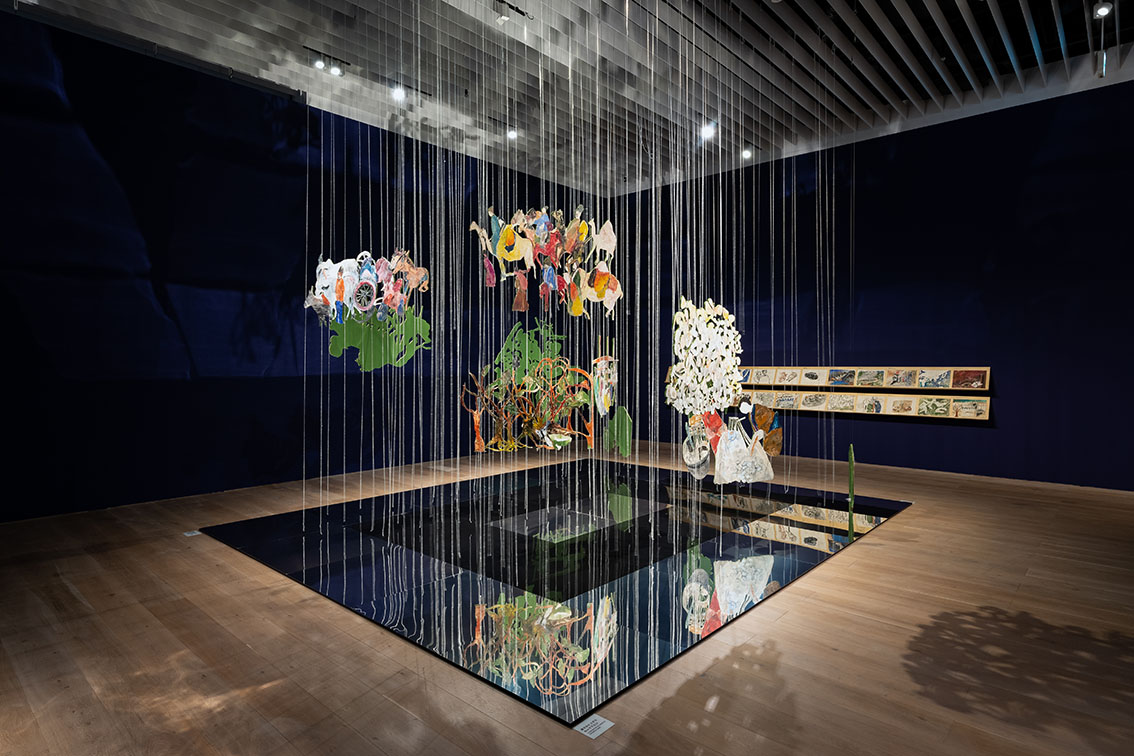アンナ・ボギギアン
Anna Boghiguian

シルクロード
2021年
インスタレーション
サイズ可変
作家蔵
撮影:古川裕也
The Silk Road
2021
Installation
Dimensions variable
Collection of the artist
Photo: Furukawa Yuya
シルクロード
2021年
インスタレーション
サイズ可変
作家蔵
撮影:古川裕也
カイロを拠点に各地を旅しながら、世界の歴史における政治や経済、産業発展の関連性などを作品に投影してきたボギギアン。本展では日本で初めて作品を発表するにあたり、世界に知られる日本の絹産業の歴史をもとに、ひとつの物語を描いています。
東西の交易路として知られるシルクロードは紀元前に始まっていますが、それはエジプトと日本を繋ぐ経路でもありました。仏教もシルクロード経由でインドから中国に伝来し、やがて日本にも伝わりました。ボギギアンはシルクロードを「交易だけでなく、知的、精神的、文化的な道」と捉えています。明治期の日本経済に繁栄をもたらした養蚕業や製糸業の発展には、明治政府の富国強兵、殖産興業政策が大きく関係しています。1872(明治5)年に設立された官営の富岡製糸場にはフランス人の技師ポール・ブリューナ(1840-1908年)も雇われ、工女の教育にはフランス人女性があたりました。全国各地に拡がった製糸業には工女の労働力が不可欠でしたが、山本茂美(1917-1998年)著『あゝ野麦峠』にも所収された「糸ひき唄」からは、その過酷な労働における悲哀を窺い知ることができます。
ボギギアンが関心を持ったのは、国家の外貨獲得や経済発展に大きく貢献した産業の背景に、困窮する家計を支える少女たちの重労働があったことでした。さらには、1896(明治29)年に日本初の動力織機を完成し、その後も数々の発明によって製糸業に貢献した豊田佐吉(1867-1939年)の精神や技術が、今日世界的な自動車メーカーに発展したトヨタ自動車の創業者で、佐吉の長男、豊田喜一郎(1894-1952年)に連なっていることにも、ボギギアンは惹かれました。
展示はこれらの物語を、天上から無数の絹糸とともに吊された絵画12点と壁面に配された24枚のドローイングと1枚の地図で構成するインスタレーションです。国家や時代と個人の関係性や特定の地域における出来事と世界の関係性が、ボギギアンの壮大な物語のなかに浮かび上がってきます。
The Silk Road
2021
Installation
Dimensions variable
Collection of the artist
Photo: Furukawa Yuya
Based in Cairo while traveling around the world, Boghiguian has projected the relationship between politics, economics, and industrial development in the context of world history onto her works. For this exhibition, her first in Japan, she depicts a narrative based on the history of Japan’s silk industry, which is renowned throughout the world.
The Silk Road, known as a trade route between East and West, began before the common era. It was also a route that connected Egypt and Japan. Buddhism was also introduced to China from India via the Silk Road, and eventually to Japan. Boghiguian sees the Silk Road as not only a trade route, but also “an intellectual, spiritual, and cultural road.” The development of the sericulture and silk manufacturing industries, which brought prosperity to the Japanese economy during the Meiji period, had a great deal to do with the Meiji government policy of enriching the country and strengthening the military, as well as boosting industrial development. The government-run Tomioka Silk Mill, established in 1872, also employed a French engineer, Paul Brunat (1840-1908), while French women were responsible for the education of the silk workers. The labor of these women was indispensable to the spreading of the silk manufacturing industry throughout Japan, and the Itohiki Uta (literally, song of silk spinning), which is included in Yamamoto Shigemi’s (1917-1998) book Ah, Nomugi Pass, gives us a glimpse of the sorrows of such hard labor.
Boghiguian was interested in the fact that behind the industries that contributed greatly to the nation’s acquisition of foreign currencies and economic development, there was the hard labor of girls who helped to support their impoverished households. She was also fascinated by the fact that the spirit and technology of Toyoda Sakichi (1867-1939), who completed Japan’s first power loom in 1896 and continued to contribute to the silk industry through his numerous inventions, was linked to that of Toyoda Kiichiro (1894-1952), Sakichi’s eldest son and the founder of Toyota Motor Corporation, which has developed into a global automobile manufacturer today.
On display is an installation of these stories, consisting of twelve paintings suspended from the ceiling with numerous silk threads and twenty-four drawings and a map on the walls. The relationship of individuals to the fate of nations and their eras, as well as that of the world to events in specific regions, emerge in Boghiguian’s grand narratives.
アーティスト一覧ARTISTS
- Etel Adnan|エテル・アドナン
- Phyllida Barlow|フィリダ・バーロウ
- Anna Boghiguian|アンナ・ボギギアン
- Miriam Cahn|ミリアム・カーン
- Lili Dujourie|リリ・デュジュリー
- Anna Bella Geiger|アンナ・ベラ・ガイゲル
- Beatriz González|ベアトリス・ゴンザレス
- Carmen Herrera|カルメン・ヘレラ
- Kim Soun-Gui|キム・スンギ
- Suzanne Lacy|スザンヌ・レイシー
- Mishima Kimiyo|三島喜美代
- Miyamoto Kazuko|宮本和子
- Senga Nengudi|センガ・ネングディ
- Nunung WS|ヌヌンWS
- Arpita Singh|アルピタ・シン
- Robin White|ロビン・ホワイト

